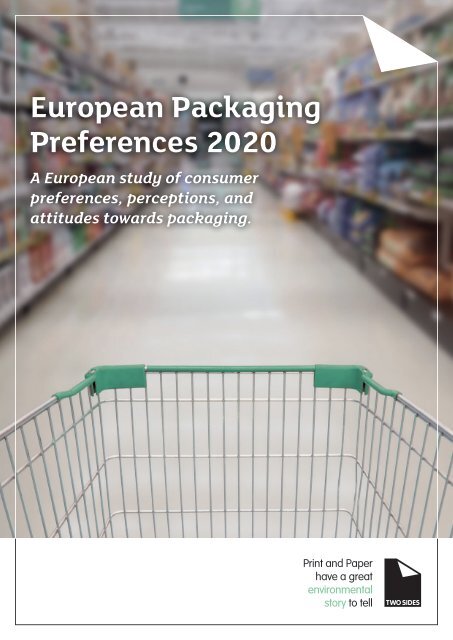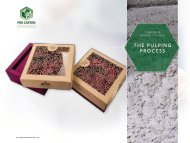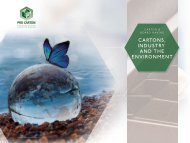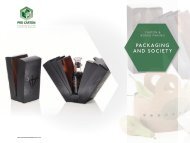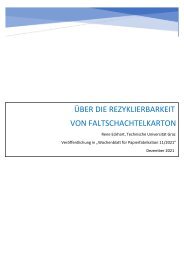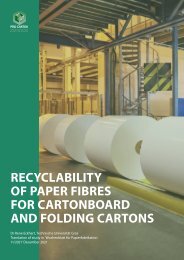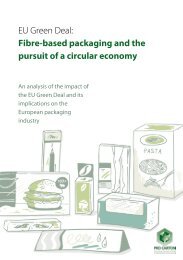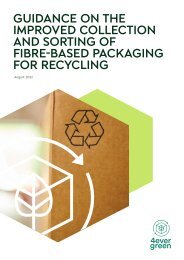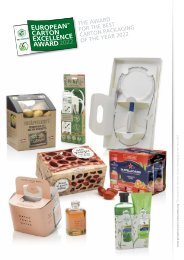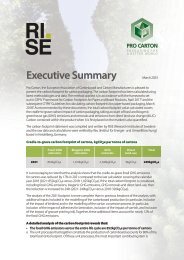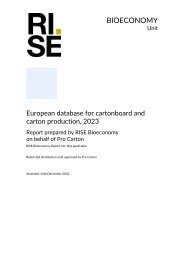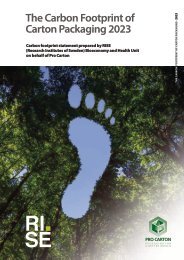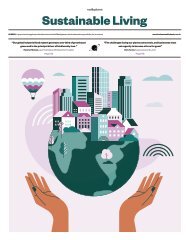European Packaging Preferences Survey by Two Sides - March 2020
- No tags were found...
You also want an ePaper? Increase the reach of your titles
YUMPU automatically turns print PDFs into web optimized ePapers that Google loves.
<strong>European</strong> <strong>Packaging</strong><br />
<strong>Preferences</strong> <strong>2020</strong><br />
A <strong>European</strong> study of consumer<br />
preferences, perceptions, and<br />
attitudes towards packaging.<br />
Print and Paper<br />
have a great<br />
environmental<br />
story to tell<br />
www.twosides.info
Introduction<br />
In <strong>March</strong> <strong>2020</strong>, a <strong>European</strong> study of 5,900<br />
consumers was commissioned <strong>by</strong> <strong>Two</strong><br />
<strong>Sides</strong> and conducted online <strong>by</strong> independent<br />
research company, Toluna.<br />
Nationally representative surveys were<br />
undertaken in Austria (500), Denmark (350),<br />
Finland (350), France (1,000), Germany (1,000),<br />
Italy (1,000), Norway (350), Sweden (350) and<br />
the UK (1,000).<br />
The survey sought to explore and understand<br />
consumer preferences, perceptions, and<br />
attitudes towards packaging.<br />
Contents<br />
3. Key Findings<br />
4. <strong>Packaging</strong> <strong>Preferences</strong><br />
6. The Importance Of Environmental Labels<br />
8. <strong>Packaging</strong> Behaviours<br />
10. Perceptions Of Retailers’ Efforts<br />
11. Perceived Recycling Rates<br />
12. The Shopping Bag<br />
14. Closing Summary<br />
15. Contact<br />
Jonathan Tame<br />
Managing Director,<br />
<strong>Two</strong> <strong>Sides</strong> Europe<br />
“<strong>Packaging</strong> is receiving more attention than ever in a bid to<br />
achieving a circular economy. Consumers are becoming<br />
more aware of the packaging choices for the items they<br />
buy, which in turn is applying pressure on businesses –<br />
particularly in retail. The culture of “make, use, dispose” is<br />
slowly changing.<br />
We have conducted this research to understand consumer<br />
perceptions when it comes to packaging. The survey<br />
revealed that paper-based packaging is the preferred<br />
choice of consumers for its environmental attributes,<br />
such as recyclability and compostability, as well as many<br />
practical factors, such as being easier to store. Whereas<br />
glass is preferred for factors such as reusability and product<br />
protection. Plastic, as perhaps expected, did not rank<br />
highest for any attribute.<br />
The survey also found that consumers throughout Europe<br />
are willing to change their behaviour in order to shop more<br />
sustainably. Many are willing to spend more on products if<br />
packaged in sustainable materials and nearly half would<br />
even avoid retailers seen not to being doing enough.<br />
These changing shopper habits emphasis the need for<br />
retailers to promote their environmental efforts more,<br />
as well as a general increase needed in awareness of<br />
environmental labels and certifications.<br />
We hope you find this report informative and useful.”<br />
About <strong>Two</strong> <strong>Sides</strong><br />
<strong>Two</strong> <strong>Sides</strong> is a not for profit global initiative promoting the<br />
unique sustainable and attractive attributes of print, paper<br />
and paper packaging.<br />
Globally, <strong>Two</strong> <strong>Sides</strong> has over 600 members spanning the<br />
print, paper and packaging value chain including: forestry,<br />
pulp, paper, packaging, inks and chemicals, finishing,<br />
publishing, printing, envelopes and postal operators.<br />
Contact <strong>Two</strong> <strong>Sides</strong><br />
If you would like to learn more about this report or find<br />
out about the many other tools and resources <strong>Two</strong> <strong>Sides</strong><br />
produce, please get in touch.<br />
+44 (0)1327 262920<br />
enquiries@twosides.info<br />
www.twosides.info<br />
@<strong>Two</strong><strong>Sides</strong>UK<br />
<strong>Two</strong> <strong>Sides</strong> Report: <strong>European</strong> <strong>Packaging</strong> <strong>Preferences</strong> <strong>2020</strong> 2
Key Findings<br />
<strong>Packaging</strong> <strong>Preferences</strong>:<br />
• Paper and cardboard packaging ranks highest with<br />
consumers for sustainability attributes including: home<br />
compostable (72%), better for the environment (62%)<br />
and easier to recycle (57%).<br />
• Glass packaging is the preferred choice for factors<br />
including: Reusable (55%) and better protection of<br />
products (51%).<br />
Consumer Behaviour:<br />
• 70% of consumers are actively taking steps to reduce<br />
their use of plastic packaging.<br />
• 48% of consumers would avoid retailers that are not<br />
actively trying to reduce their use of non-recyclable<br />
plastic packaging.<br />
• 58% of <strong>European</strong>s believe non-recyclable packaging<br />
should be discouraged through taxation.<br />
Online Shopping:<br />
• 66% of consumers prefer products ordered online to<br />
be delivered in paper packaging rather than plastic<br />
packaging.<br />
• 73% of consumers prefer products ordered online to<br />
be delivered in fitting packaging, i.e. not too big for the<br />
size of the actual product.<br />
Recycling Perceptions:<br />
• Paper/cardboard packaging is considered to be<br />
the most recycled material, with 30% of consumers<br />
believing the <strong>European</strong> recycling rate to be over 60%<br />
(85% of paper and cardboard packaging is recycled*).<br />
• 23% of consumers believe glass has a recycling rate in<br />
excess of 60%. (Glass packaging has a recycling rate<br />
of 74%*).<br />
• 17% of consumers believe metal has a recycling rate<br />
in excess of 60%. (Metallic packaging has a recycling<br />
rate of 80%*).<br />
• Plastic is considered to be the least recycled packaging<br />
material. Although 12% of consumers overestimate<br />
the recycling rate of plastic, believing it to be over 60%.<br />
(Plastic packaging has a recycling rate of 42% in Europe*).<br />
Environmental Labels:<br />
• 64% are aware of the Forest Stewardship Council®<br />
(FSC®), and 55% are aware of the Programme for<br />
the Endorsement of Forest Certification (PEFC).<br />
<strong>European</strong>s consider FSC slightly more important than<br />
PEFC.<br />
• The Mobius Loop (recyclable) is the most recognised<br />
label in Europe, with 86% being aware of it. It is also<br />
rated the most important label <strong>by</strong> consumers.<br />
The Shopping Bag:<br />
• Consumers ranked paper bags highest for<br />
environmental factors such as: recyclability (52%),<br />
compostability (47%) and made with renewable<br />
materials (43%).<br />
• Cotton/canvas bags were ranked highly on physical<br />
characteristics such as: premium feel (59%), durability<br />
(55%) and attractiveness (52%).<br />
*Eurostat, 2017.<br />
www.twosides.info / @<strong>Two</strong><strong>Sides</strong>UK / enquiries@twosides.info 3
<strong>Packaging</strong> <strong>Preferences</strong><br />
The value of the <strong>European</strong> packaging market was €195 billion in 2018, forecast to reach €214 billion in 2023<br />
(packagingeurope.com, 2019). <strong>Packaging</strong> plays an extremely important part in the purchasing decision, as it displays vital<br />
product information and is used to preserve or enhance product quality. <strong>Packaging</strong> can come in a variety of forms and the<br />
packaging industry is always innovating to meet the demands of the consumer.<br />
The subject of sustainability has been prevalent in the packaging industry, as packaging tends to be disposed of when a<br />
product has been purchased and unpacked. Consumer perceptions of the environmental impact of different packaging<br />
materials is therefore important to understand.<br />
In addition to understanding consumer perceptions of environmental attributes, such as a material’s recyclability or<br />
compostability, respondents were also asked to choose their preferred materials based on practical and visual attributes,<br />
such as product protection and ease of opening/closing.<br />
To begin, we asked respondents about 4 different packaging materials: paper/cardboard, glass, plastic, and metal.<br />
Looking at 15 different attributes, respondents were asked to match the material that they thought best suit each one. Of the<br />
15 attributes, paper/cardboard was the average <strong>European</strong> favourite for 10, glass for 4, metal for 1, and plastic for none.<br />
Paper/cardboard is the preferred material for the following 10 attributes<br />
72%<br />
HOME COMPOSTABLE<br />
• 72% chose paper/cardboard on<br />
average. Particularly strong in Austria<br />
(77%), Germany (74%) and Italy (76%).<br />
• Glass is next highest at 6%.<br />
63%<br />
BETTER FOR THE ENVIRONMENT<br />
• 63% chose paper/cardboard on<br />
average. The preference is particularly<br />
strong in UK (69%), Italy (64%) and<br />
Denmark (69%).<br />
• Glass is next highest preference at<br />
27%.<br />
LIGHTER WEIGHT<br />
62% 57%<br />
• 62% chose paper/cardboard on<br />
average. Particularly strong in Italy<br />
(69%), the UK (66%) and Austria (66%).<br />
• Plastic is next highest at 26%.<br />
EASIER TO RECYCLE<br />
• 57% chose paper/cardboard on<br />
average. Particularly strong in the UK,<br />
Austria, Sweden and Norway (all 61%).<br />
• Glass is next highest at 28%.<br />
LESS EXPENSIVE<br />
54% 41%<br />
• 54% chose paper/cardboard on<br />
average. Particularly strong in the UK<br />
(63%), Italy (56%) and Sweden (58%).<br />
• Plastic is next highest at 22%.<br />
EASIER TO OPEN/CLOSE<br />
• 41% chose paper/cardboard on<br />
average. Particularly strong in the UK<br />
(52%) and Finland (49%).<br />
• Glass is next highest at 31%.<br />
<strong>Two</strong> <strong>Sides</strong> Report: <strong>European</strong> <strong>Packaging</strong> <strong>Preferences</strong> <strong>2020</strong> 4
41%<br />
EASIER TO STORE<br />
• 41% chose paper/cardboard on<br />
average. Particularly strong in Austria<br />
(52%), Italy (48%) and Germany (47%).<br />
• Glass is next highest at 21%.<br />
40%<br />
MORE PRACTICAL<br />
• 40% chose paper/cardboard on<br />
average. Particularly strong in Italy<br />
(48%), Sweden (44%) and the UK<br />
(41%).<br />
• Plastic is next highest at 26%.<br />
SAFER TO USE<br />
37% 36%<br />
• 37% chose paper/cardboard on<br />
average. Particularly strong in Finland<br />
(56%) and the UK (53%).<br />
• Glass is next highest at 31%.<br />
BETTER PRODUCT INFORMATION<br />
• 36% chose paper/cardboard on<br />
average. Particularly strong in Italy<br />
(49%) and Finland (42%).<br />
• Glass is next highest at 21%.<br />
Glass is the preferred material for the following 4 attributes<br />
REUSABLE<br />
55% 51%<br />
• 55% chose glass on average.<br />
Particularly strong in Austria (70%)<br />
and France (66%).<br />
• Paper is next highest at 22%.<br />
BETTER PROTECTION<br />
• 51% of consumers chose glass on<br />
average. Particularly strong in Italy<br />
(70%) and France (64%).<br />
• Metal and plastic are the next highest<br />
at 15%.<br />
41%<br />
PREFER LOOK AND FEEL<br />
• 41% chose glass on average.<br />
Particularly strong in France (50%) and<br />
Austria (47%).<br />
39%<br />
BETTER BRAND IMAGE<br />
• 39% chose glass on average.<br />
Particularly strong in Germany (49%)<br />
and Italy (48%).<br />
• Paper is next highest at 28%.<br />
• Paper is next highest at 31%.<br />
Metal is the preferred material for the following attribute<br />
51%<br />
STRONGER/MORE ROBUST<br />
• 51% of consumers chose metal, on<br />
average. Particularly strong in Finland<br />
(58%) and Norway (56%).<br />
• Glass is next highest at 22%.<br />
www.twosides.info / @<strong>Two</strong><strong>Sides</strong>UK / enquiries@twosides.info 5
The Importance Of Environmental Labels<br />
Environmental labels are an important factor of packaging as it allows consumers to understand the environmental<br />
attributes of a product or its packaging, which could influence their purchasing decisions. Environmental labels will include<br />
forest certification schemes, recyclability, and composability. Respondents were asked how important they perceived each<br />
environmental label to be.<br />
Consumers were asked to rate a selection of environmental labels for importance, using a rating of 1 to 5 (1 for being least<br />
important and 5 for most important). They were also given the option of “unaware of this label”.<br />
The first two labels were in relation to forest certification schemes. 60% of <strong>European</strong> consumers are aware of the two main<br />
forest certification labels, which are the Forest Stewardship Council® (64% aware), and the Programme for the Endorsement<br />
of Forest Certification (55% aware).<br />
Average ranking of importance for the FSC ® and PEFC<br />
environmental labels <strong>by</strong> Country<br />
4.0<br />
3.5<br />
3.7<br />
3.0<br />
2.5<br />
3.3<br />
3.1<br />
3.3<br />
3.1<br />
3.2<br />
3.1<br />
3.3<br />
3.2<br />
3.3<br />
3.2<br />
3.3<br />
3.1<br />
3.5<br />
3.1<br />
2.9<br />
3.3<br />
3.0<br />
3.4<br />
3.0<br />
FSC ®<br />
2.0<br />
PEFC<br />
1.5<br />
1.0<br />
0.5<br />
0.0<br />
<strong>European</strong><br />
Average<br />
Austria Denmark Finland France Germany Italy Norway Sweden UK<br />
FSC ®<br />
The survey found that 64% of <strong>European</strong> consumers are aware of this label. Countries with the most<br />
awareness of FSC are Italy (74%) and the UK (73%). Norway is the least aware of this label at 51%.<br />
Respondents aware of FSC gave it an average score of 3.5/5 for importance. It is perceived as most<br />
important in Italy (3.7/5) and the UK (3.4/5).<br />
PEFC<br />
The survey found that 55% of <strong>European</strong> consumers are aware of this label. Countries with the most<br />
awareness of PEFC are Italy (67%) and France (60%). Norway is the least aware of this label at 41%.<br />
Respondents aware of PEFC gave it an average score of 3.1/5 for importance. It is perceived as most<br />
important in Italy (3.5/5) and France (3.2/5).<br />
<strong>Two</strong> <strong>Sides</strong> Report: <strong>European</strong> <strong>Packaging</strong> <strong>Preferences</strong> <strong>2020</strong> 6
Mobius Loop<br />
This label indicates that an object is capable of being recycled, not that the<br />
object has been recycled or will be accepted in all recycling collection systems.<br />
Source: Recycle Now<br />
86% of consumers are aware of the recyclable label (mobius loop) and gave<br />
it an average score of 3.7/5 for importance. This suggests that they are aware<br />
and place importance in the recyclability of packaging, regardless of the<br />
material. Finland (93%), Sweden (92%) and Italy (89%) are most aware of the<br />
mobius loop.<br />
The Green Dot<br />
The Green Dot does not necessarily mean that the packaging is recyclable,<br />
will be recycled or has been recycled. It is a symbol used on packaging in<br />
some <strong>European</strong> countries and signifies that the producer has made a financial<br />
contribution towards the recovery and recycling of packaging in Europe.<br />
Source: Recycle Now<br />
84% of respondents are aware of this label. The Green Dot also scored an<br />
average of 3.6/5 for importance. Consumers are most aware of this label in<br />
Germany (93%) and Austria (89%).<br />
EU Ecolabel<br />
The EU Ecolabel is a label of environmental excellence that is awarded to<br />
products and services meeting high environmental standards throughout their<br />
life cycle. The label promotes the circular economy.<br />
Source: <strong>European</strong> Commission<br />
61% of <strong>European</strong> consumers are aware of this label. The average score of<br />
importance for this label is 3.4/5. Consumers are most aware of the EU<br />
Ecolabel in Germany (93%), Austria (89%) and France (85%).<br />
The Seedling (Compostable)<br />
Products certified to be industrially compostable according to the <strong>European</strong><br />
standard EN 13432/14955 may bear the ‘seedling’ logo.<br />
Source: Recycle Now<br />
45% of <strong>European</strong> consumers are aware of this label, with an importance<br />
score of 3.1/5. Consumers are most aware of this label in Italy (60%), the UK<br />
(47%) and Finland (43%).<br />
www.twosides.info / @<strong>Two</strong><strong>Sides</strong>UK / enquiries@twosides.info 7
Consumer <strong>Packaging</strong> Behaviours<br />
Consumer awareness of how packaging is impacting the planet is increasing, in part due to informative documentaries<br />
such as David Attenborough’s Blue Planet 2. Since the BBC programme was broadcast in late 2017, packaging, and<br />
sustainability more generally, has played a significant part in governmental policies around the globe, as well as featuring<br />
heavily in the media, public discourse and throughout boardrooms.<br />
The increasing number of environmentally conscious consumers, as well as governmental policies on reducing waste, is<br />
causing retailers and producers to drastically improve their green credentials. Respondents were asked to what extent they<br />
agree with the following series of statements:<br />
“I am actively taking steps to reduce my use of plastic packaging.”<br />
70% of respondents agreed, or strongly agreed.<br />
EUROPE<br />
21% 43% 27%<br />
GERMANY<br />
21% 42% 27%<br />
AUSTRIA<br />
18% 44% 28%<br />
ITALY<br />
15% 48% 34%<br />
DENMARK<br />
9% 27% 41% 20%<br />
NORWAY<br />
12% 25% 40%<br />
19%<br />
FINLAND<br />
8% 26% 40% 20%<br />
SWEDEN<br />
26% 38% 25%<br />
FRANCE<br />
22% 45% 25%<br />
0% 20% 40% 60% 80% 100%<br />
UK<br />
22% 40% 29%<br />
0% 20% 40% 60% 80% 100%<br />
Strongly Disagree Disagree Neither Agree Nor Disagree Agree Strongly Agree<br />
“I would be willing to spend more on a product if it were packaged using sustainable materials.”<br />
44% of respondents agreed, or strongly agreed.<br />
EUROPE<br />
15%<br />
33% 32% 12%<br />
GERMANY<br />
14% 32% 31% 11%<br />
AUSTRIA<br />
17%<br />
30% 30% 12%<br />
ITALY<br />
12% 29% 39%<br />
14%<br />
DENMARK<br />
14% 35% 35% 9%<br />
NORWAY<br />
18% 36% 29%<br />
9%<br />
FINLAND 17% 36% 32% 7%<br />
FRANCE 15% 34% 30% 12%<br />
0% 20% 40% 60% 80% 100%<br />
SWEDEN<br />
11% 37% 30% 13%<br />
UK 18% 32% 29% 12%<br />
0% 20% 40% 60% 80% 100%<br />
Strongly Disagree Disagree Neither Agree Nor Disagree Agree Strongly Agree<br />
“I now buy more from retailers who are removing plastic from their packaging.”<br />
46% of respondents agreed, or strongly agreed.<br />
EUROPE<br />
11% 39% 33% 13%<br />
GERMANY<br />
13% 38% 29% 13%<br />
AUSTRIA<br />
16%<br />
34% 32% 12%<br />
ITALY<br />
35% 41%<br />
15%<br />
DENMARK<br />
13% 48% 27%<br />
NORWAY<br />
14% 43% 28%<br />
9%<br />
FINLAND<br />
13%<br />
46% 27% 8%<br />
SWEDEN<br />
8% 48% 28% 12%<br />
FRANCE 10% 35% 36%<br />
15%<br />
0% 20% 40% 60% 80% 100%<br />
UK 11% 38% 33% 14%<br />
0% 20% 40% 60% 80% 100%<br />
Strongly Disagree Disagree Neither Agree Nor Disagree Agree Strongly Agree<br />
<strong>Two</strong> <strong>Sides</strong> Report: <strong>European</strong> <strong>Packaging</strong> <strong>Preferences</strong> <strong>2020</strong> 8
“I would consider avoiding a retailer if I knew they were not actively trying to reduce their use of non-recyclable plastic packaging.”<br />
48% of respondents agreed, or strongly agreed.<br />
EUROPE<br />
11% 35% 34% 14%<br />
GERMANY<br />
14% 38% 30% 10%<br />
AUSTRIA<br />
14%<br />
37% 31% 11%<br />
ITALY<br />
28% 47%<br />
17%<br />
DENMARK<br />
11% 44% 30% 11%<br />
NORWAY<br />
11% 39% 31%<br />
14%<br />
FINLAND<br />
13%<br />
38% 32% 12%<br />
SWEDEN<br />
9% 36% 35%<br />
16%<br />
FRANCE 9% 36% 35%<br />
16%<br />
0% 20% 40% 60% 80% 100%<br />
UK 15% 34% 30% 16%<br />
0% 20% 40% 60% 80% 100%<br />
Strongly Disagree Disagree Neither Agree Nor Disagree Agree Strongly Agree<br />
“Non-recyclable packaging should be discouraged through taxation.”<br />
58% of respondents agreed, or strongly agreed.<br />
EUROPE<br />
8% 28% 34% 24%<br />
GERMANY<br />
11% 32% 30% 18%<br />
AUSTRIA<br />
13%<br />
26% 33% 18%<br />
ITALY<br />
22% 38%<br />
33%<br />
DENMARK<br />
37% 36% 17%<br />
NORWAY<br />
11% 33% 31%<br />
20%<br />
FINLAND<br />
9%<br />
32% 32% 22%<br />
SWEDEN<br />
34% 29%<br />
25%<br />
FRANCE 26% 37%<br />
25%<br />
0% 20% 40% 60% 80% 100%<br />
UK 28% 35%<br />
27%<br />
0% 20% 40% 60% 80% 100%<br />
Strongly Disagree Disagree Neither Agree Nor Disagree Agree Strongly Agree<br />
“I prefer products ordered online to be delivered in paper packaging rather than plastic packaging.”<br />
66% of respondents agreed, or strongly agreed.<br />
EUROPE<br />
23% 38% 28%<br />
GERMANY<br />
23% 38%<br />
27%<br />
AUSTRIA<br />
21% 38% 35%<br />
ITALY<br />
16% 45%<br />
32%<br />
DENMARK<br />
29% 36% 20%<br />
NORWAY<br />
9% 23% 40%<br />
20%<br />
FINLAND<br />
27% 38% 21%<br />
SWEDEN<br />
25% 33%<br />
31%<br />
FRANCE 25% 38%<br />
27%<br />
0% 20% 40% 60% 80% 100%<br />
UK 23% 34%<br />
32%<br />
0% 20% 40% 60% 80% 100%<br />
Strongly Disagree Disagree Neither Agree Nor Disagree Agree Strongly Agree<br />
“I prefer products ordered online to be delivered in a fitting packaging e.g. that is not too big for the size of the actual product.”<br />
73% of respondents agreed, or strongly agreed.<br />
EUROPE<br />
21% 40% 33%<br />
GERMANY<br />
22% 38%<br />
31%<br />
AUSTRIA<br />
16% 41% 37%<br />
ITALY<br />
15% 44%<br />
38%<br />
DENMARK<br />
26% 42% 22%<br />
NORWAY<br />
25% 38%<br />
28%<br />
FINLAND<br />
31% 40% 21%<br />
SWEDEN<br />
29% 34%<br />
29%<br />
FRANCE 19% 40%<br />
37%<br />
0% 20% 40% 60% 80% 100%<br />
UK 20% 39%<br />
35%<br />
0% 20% 40% 60% 80% 100%<br />
Strongly Disagree Disagree Neither Agree Nor Disagree Agree Strongly Agree<br />
www.twosides.info / @<strong>Two</strong><strong>Sides</strong>UK / enquiries@twosides.info 9
Perceptions Of Retailers’ Efforts<br />
Retailers, particularly supermarkets, throughout Europe have been improving their environmental commitments. We asked<br />
respondents which retailers they perceive to be doing the most to reduce their use of non-recyclable packaging. We have<br />
already established that this is important to consumers with an average of 48% stating they would consider avoiding a retailer<br />
if they were not taking steps to reduce their use of non-recyclable plastic packaging.<br />
Overall, an average of 30% of respondents are unsure of the efforts retailers are making to increase their use of<br />
environmentally friendly packaging. Those in the Germany, Norway and the UK appear most uncertain. Those in Denmark<br />
appear most aware of retailers’ efforts.<br />
We asked consumers to rank retailers to establish which ones they believe to be putting in the most effort to increase their use<br />
of environmentally friendly packaging.<br />
Retailers considered to be doing the most to increase their use<br />
of environmentally friendly packaging<br />
Austria<br />
1. Spar<br />
2. Merkur<br />
3. Hofer<br />
Finland<br />
1. S-Market<br />
2. K-Market<br />
3. Lidl<br />
Norway<br />
1. Kiwi<br />
2. Coop<br />
3. Meny<br />
Denmark<br />
1. Coop<br />
2. Rema 1000<br />
3. Lidl<br />
Germany<br />
1. Edeka<br />
2. REWE<br />
3. Kaufland<br />
Sweden<br />
1. ICA<br />
2. Coop<br />
3. Willys<br />
France<br />
1. Biocoop<br />
2. Bio C’Bon<br />
3. Naturalia<br />
Italy<br />
1. Coop<br />
2. Esselunga<br />
3. Conad<br />
UK<br />
1. Waitrose<br />
2. Sainsburys<br />
3. Tesco and Morrisons<br />
In every country, the average score for each retailer was between 2.5-3.5 out of 5. No retailers scored above 3.5/5,<br />
showing that consumers do not rate any retailer highly in concerns of their efforts to increase their use of environmentally<br />
friendly packaging.<br />
<strong>Two</strong> <strong>Sides</strong> Report: <strong>European</strong> <strong>Packaging</strong> <strong>Preferences</strong> <strong>2020</strong> 10
Perceived Recycling Rates<br />
<strong>Packaging</strong> that is irresponsibly disposed of has a negative impact on the natural environment. For instance, each year, at<br />
least 8 million tonnes of plastics leak into the ocean (Ellen MacArthur Foundation, 2016).<br />
Recycling packaging enables the value of the materials to be maintained and avoids polluting the environment. In Europe,<br />
currently 67% of packaging (across all material types) is recycled.<br />
The perceived recycling rate for paper/<br />
cardboard packaging <strong>by</strong> <strong>European</strong> consumers<br />
The perceived recycling rate for plastic<br />
packaging <strong>by</strong> <strong>European</strong> consumers<br />
10%<br />
12%<br />
30%<br />
PAPER &<br />
CARDBOARD<br />
Actual Rate = 85%<br />
25%<br />
25%<br />
PLASTIC<br />
Actual Rate = 42%<br />
27%<br />
35%<br />
36%<br />
0% - 19% 20% - 39% 40% - 59% Over 60%<br />
0% - 19% 20% - 39% 40% - 59% Over 60%<br />
The survey revealed that paper/cardboard packaging is<br />
considered the most recycled <strong>by</strong> <strong>European</strong> consumers,<br />
with an average of 30% of respondents believing that the<br />
recycling rate is over 60%. However, just 9% of respondents<br />
believe the paper recycling rate to be more than 70%.<br />
85% of paper/cardboard packaging is recycled in Europe*.<br />
Overall, plastic is considered to be the least recycled<br />
packaging material. Although 12% of consumers<br />
overestimate the recycling rate of plastic, believing it to be<br />
over 60%. Plastic packaging has a recycling rate of 42% in<br />
Europe*.<br />
The perceived recycling rate for glass<br />
packaging <strong>by</strong> <strong>European</strong> consumers<br />
The perceived recycling rate for metal<br />
packaging <strong>by</strong> <strong>European</strong> consumers<br />
23%<br />
16%<br />
17%<br />
22%<br />
GLASS<br />
METAL<br />
Actual Rate = 74%<br />
32%<br />
28%<br />
Actual Rate = 80%<br />
29%<br />
33%<br />
0% - 19% 20% - 39% 40% - 59% Over 60%<br />
0% - 19% 20% - 39% 40% - 59% Over 60%<br />
An average of 23% of respondents believe glass has<br />
a recycling rate over 60%. 74% of glass packaging is<br />
recycled in Europe*.<br />
An average of 17% of consumers believe metal had a<br />
recycling rate over 60%. 80% of metallic packaging is<br />
recycled in Europe*.<br />
*Eurostat, 2017.<br />
www.twosides.info / @<strong>Two</strong><strong>Sides</strong>UK / enquiries@twosides.info 11
The Shopping Bag<br />
Retailers have come under pressure to reduce their use of single-use plastics. This has resulted in attention turning to the<br />
shopping bags used after purchase, with retailers now offering plastic, paper, and canvas options. We asked consumers<br />
which attributes best suited the material options used for shopping bags to understand their preferences at check-out.<br />
Consumers were asked their opinions on cotton/canvas, brown paper, white paper, lightweight plastic, and heavyweight<br />
plastic bags.<br />
Whilst cotton bags were well liked for their attractiveness and durability, when it came to the impact on the environment,<br />
consumers favoured the paper bag for being recyclable, compostable and made from renewable materials.<br />
Out of the 10 attributes, on average cotton/canvas bags are perceived best fit for 7, paper bags are perceived best fit for 3<br />
and plastic bags best fit for none.<br />
On environmental criteria, paper bags (brown paper<br />
bags and white paper bags combined) are the clear<br />
preference for 3 attributes:<br />
• Recyclable – 52% prefer paper bags for this<br />
attribute, on average (58% in UK, 56% in France).<br />
Cotton/canvas and plastic bags are preferred <strong>by</strong><br />
23% of consumers for this attribute.<br />
• Paper bags are also perceived as best fit,<br />
on average, for being compostable (47%)<br />
but results varied <strong>by</strong> country. There was a<br />
particularly strong preference in France (57%),<br />
Sweden (52%), the UK (50%) and Italy (49%).<br />
• Made with renewable materials – 43% of<br />
respondents prefer paper bags for this attribute,<br />
on average (49% in Austria). Cotton/canvas<br />
bags are preferred <strong>by</strong> 33% of consumers for this<br />
attribute.<br />
52%<br />
prefer paper bags<br />
for their recyclable<br />
attributes<br />
43%<br />
of consumers think paper<br />
bags are made from<br />
renewable materials.<br />
47%<br />
of consumers perceive<br />
paper bags to be home<br />
compostable<br />
Cotton/canvas bags has the highest average rating<br />
across all countries for 6 attributes:<br />
• High quality/Premium feel – 59% prefer cotton/<br />
canvas bags. Particularly strong preference in Austria<br />
(78%) and Germany (70%). Paper bags are preferred<br />
<strong>by</strong> 19% of consumers for this attribute.<br />
• Reusable – 56% prefer cotton/canvas bags.<br />
Particularly strong preference in Austria (61%),<br />
Germany (64%) and Italy (60%). Both paper bags and<br />
plastic bags are preferred <strong>by</strong> 20% of consumers for<br />
this attribute.<br />
• Durable e.g. strong/unlikely to break – 55% prefer<br />
cotton/canvas bags. Particularly strong preference in<br />
Austria (69%) and Germany (63%). Plastic bags are<br />
preferred <strong>by</strong> 26% of consumers and paper bags <strong>by</strong><br />
17% for this attribute.<br />
• ‘I prefer this type of bag’ – 53% simply prefer cotton/<br />
canvas bags on average (Austria 60%). 21% prefer<br />
plastic bags and 20% prefer paper bags.<br />
• Attractive e.g. colours/branding – 52% on average<br />
prefer cotton/canvas bags. There is a particularly<br />
strong preference in Austria (69%) and Germany (63%).<br />
In comparison, paper bags were preferred <strong>by</strong> 24% of<br />
consumers for attractiveness (up to 34% in Italy).<br />
• Enhances the quality of the purchased goods carried<br />
with the bag – 50% prefer cotton/canvas bags.<br />
Particularly strong preference in Austria (65%) and<br />
Germany (60%). Paper bags are preferred <strong>by</strong> 24% of<br />
consumers for this attribute.<br />
• Low carbon footprint - 41% perceive cotton/canvas<br />
bags to have a low carbon footprint. Particularly strong<br />
in Germany (55%) and Austria (58%). Paper bags is<br />
preferred <strong>by</strong> 36%.<br />
Plastic is the least preferred option across all 10 attributes.<br />
However, respondents ranked plastic higher for durability<br />
(25%) than paper bags (17%).<br />
<strong>Two</strong> <strong>Sides</strong> Report: <strong>European</strong> <strong>Packaging</strong> <strong>Preferences</strong> <strong>2020</strong> 12
Consumers were also asked how often they re-use each type of shopping bag. The number of times that paper and plastic<br />
bags are re-used varies. Consumers claim to re-use cotton/canvas bags the most (more than 10 times).<br />
The average amount a paper bag is reused<br />
among <strong>European</strong> consumers<br />
The average amount a cotton/canvas bags is<br />
reused among <strong>European</strong> consumers<br />
12%<br />
6%<br />
5%<br />
27%<br />
7%<br />
PAPER BAG<br />
27% would reuse<br />
2 or 3 times<br />
21%<br />
22%<br />
Never<br />
Once<br />
2 or 3 times<br />
4 or 5 times<br />
6 - 10 times<br />
More than<br />
10 times<br />
Not Applicable<br />
60%<br />
4%<br />
COTTON/<br />
CANVAS BAG<br />
60% would reuse<br />
more than 10<br />
times<br />
6%<br />
6%<br />
10%<br />
6%<br />
8%<br />
Never<br />
Once<br />
2 or 3 times<br />
4 or 5 times<br />
6 - 10 times<br />
More than<br />
10 times<br />
Not Applicable<br />
Paper Bags: 27% respondents said they would reuse a<br />
paper bag 2 or 3 times, followed <strong>by</strong> 22% who would use<br />
it once.<br />
Cotton/Canvas: 60% of respondents would reuse a<br />
cotton/canvas bag more than 10 times, followed <strong>by</strong> 10%<br />
who would use it 2 or 3 times.<br />
The average amount a heavyweight plastic<br />
bags is reused among <strong>European</strong> consumers<br />
The average amount a lightweight plastic<br />
bags is reused among <strong>European</strong> consumers<br />
7%<br />
17%<br />
Never<br />
Once<br />
9%<br />
7%<br />
18%<br />
Never<br />
Once<br />
25%<br />
12%<br />
HEAVYWEIGHT<br />
PLASTIC BAG<br />
25% would reuse<br />
more than 10<br />
times<br />
15%<br />
14%<br />
10%<br />
2 or 3 times<br />
4 or 5 times<br />
6 - 10 times<br />
More than<br />
10 times<br />
Not Applicable<br />
8%<br />
13%<br />
LIGHTWEIGHT<br />
PLASTIC BAG<br />
24% would reuse<br />
2 or 3 times<br />
24%<br />
22%<br />
2 or 3 times<br />
4 or 5 times<br />
6 - 10 times<br />
More than<br />
10 times<br />
Not Applicable<br />
Heavyweight plastic bags: 25% of respondents would<br />
reuse a heavyweight plastic bag more than 10 times,<br />
followed <strong>by</strong> 17% who would never reuse it.<br />
Lightweight plastic bags: 24% of respondents would reuse<br />
a lightweight plastic bag 2 or 3 times, followed <strong>by</strong> 22%<br />
who only use it once<br />
In recent years, there has been growing recognition of the impact of single-use packaging, particularly plastic, has on the<br />
environment. Relatively little plastic packaging is recycled (42% <strong>European</strong> average in 2017 and just 14% globally) and when<br />
discarded irresponsibly, it is a significant contributor to marine pollution.<br />
Although it is better for the environment to reuse shopping bags to reduce waste, it’s also important to look at the full<br />
life cycle of each shopping bag to understand its true impact on the environment. For instance, research suggests that<br />
cotton bags need to be used at least 50 times to achieve the same climate performance as paper bags (The Danish<br />
Environmental Protection Agency, Life Cycles Assessment of grocery carrier bags, 2018).<br />
www.twosides.info / @<strong>Two</strong><strong>Sides</strong>UK / enquiries@twosides.info 13
Closing Summary<br />
The findings suggest that consumers are becoming more aware of the impact that packaging is having on the<br />
environment, particularly in relation to single use and non-recyclable packaging. Most are actively taking steps to reduce<br />
their use of plastic packaging (70%), but also, they recognise that paper/cardboard can be a more sustainable option.<br />
62% perceived paper/cardboard to be better for the environment, 57% perceived it as being easier to recycle, and 72%<br />
recognising that it is home compostable.<br />
There is an increasing level of pressure on retailers to increase their use of environmentally friendly packaging, with 48%<br />
of consumers agreeing that they would consider avoiding a retailer if they knew they were not actively trying to reduce<br />
their use of non-recyclable packaging. Additionally, 58% of consumers agreed that non-recyclable packaging should be<br />
discouraged through taxation.<br />
The findings in relation to recycling rates also suggest paper/cardboard as being the most recycled packaging material<br />
in Europe. However, a significant amount of consumers still underestimate the recycling rates of paper, glass and metal<br />
packaging, meaning more needs to be done <strong>by</strong> these industries to improve perceptions and understanding.<br />
For more research and reports from <strong>Two</strong> <strong>Sides</strong>, please visit www.twosides.info<br />
About <strong>Two</strong> <strong>Sides</strong><br />
<strong>Two</strong> <strong>Sides</strong> is a not for profit global initiative promoting the<br />
unique sustainable and attractive attributes of print, paper<br />
and paper packaging.<br />
Globally, <strong>Two</strong> <strong>Sides</strong> has over 600 members spanning the<br />
print, paper and packaging value chain including: forestry,<br />
pulp, paper, packaging, inks and chemicals, finishing,<br />
publishing, printing, envelopes and postal operators.<br />
Contact <strong>Two</strong> <strong>Sides</strong><br />
If you would like to learn more about this report or find<br />
out about the many other tools and resources <strong>Two</strong> <strong>Sides</strong><br />
produce, please get in touch.<br />
+44 (0)1327 262920<br />
enquiries@twosides.info<br />
www.twosides.info<br />
@<strong>Two</strong><strong>Sides</strong>UK<br />
<strong>Two</strong> <strong>Sides</strong> Report: <strong>European</strong> <strong>Packaging</strong> <strong>Preferences</strong> <strong>2020</strong> 14
Contact<br />
<strong>Two</strong> <strong>Sides</strong> Europe<br />
<strong>Two</strong> <strong>Sides</strong> UK<br />
iCon Centre<br />
Eastern Way<br />
Daventry<br />
NN11 0QB<br />
United Kingdom<br />
Please contact Jonathan Tame;<br />
Telephone: +44 (0) 1327 262920<br />
Email: jonathan@twosides.info<br />
<strong>Two</strong> <strong>Sides</strong> Germany<br />
Fasanenweg 3<br />
21227 Bendestorf<br />
Germany<br />
Please contact Anne-Katrin Kohlmorgen;<br />
Telephone: +49 (0) 40 4140 639-11<br />
Email: anne@twosides.info<br />
<strong>Two</strong> <strong>Sides</strong> Italy<br />
Bastioni di Porta Volta, 7<br />
20121 Milano<br />
Italy<br />
Please contact Massimo Ramunni;<br />
Telephone: +39 02 29003018<br />
Email: massimo@twosides.info<br />
<strong>Two</strong> <strong>Sides</strong> France<br />
23-25 rue d’Aumale<br />
75009 Paris<br />
France<br />
Please contact Jan Le Moux;<br />
Telephone: +33 (1) 53 89 24 00<br />
Email: jan@twosides.info<br />
<strong>Two</strong> <strong>Sides</strong> Austria<br />
Gumpendorfer Strasse 6<br />
1060 Wien<br />
Austria<br />
Please contact Patrick Mader;<br />
Telephone: +43 1 588 86 273<br />
Email: patrick@twosides.info<br />
<strong>Two</strong> <strong>Sides</strong> Nordics<br />
Upplandsgatan 84<br />
113 44 Stockholm<br />
Sweden<br />
Please contact Magnus Thorkildsen;<br />
Telephone: 00 47 97 58 70 85<br />
Email: magnus@twosides.info<br />
<strong>Two</strong> <strong>Sides</strong> International<br />
<strong>Two</strong> <strong>Sides</strong> North America<br />
330 North Wabash Avenue<br />
Suite 2000<br />
Chicago, Illinois 60611<br />
USA<br />
Please contact Phil Riebel;<br />
Telephone: 855-896-7433<br />
Email: phil@twosidesna.org<br />
<strong>Two</strong> <strong>Sides</strong> Brazil<br />
Rua Bresser, 2315<br />
São Paulo - São Paulo<br />
Brasil<br />
CEP 03162-030<br />
Please contact Fabio Mortara;<br />
Telephone: 55 11 97206-4746<br />
Email: fam@twosides.org.br<br />
<strong>Two</strong> <strong>Sides</strong> Australia & New Zealand<br />
Suite 6<br />
151 Barkly Avenue<br />
Richmond VIC 3121<br />
Please contact Kellie Northwood;<br />
Telephone: 03 9421 2209<br />
Email: kellie@thermc.com.au<br />
<strong>Two</strong> <strong>Sides</strong> South Africa<br />
575 Lupton Drive<br />
Midrand<br />
Johannesburg<br />
1682<br />
Please contact Deon Joubert;<br />
Email: deon@za.twosides.info<br />
www.twosides.info / @<strong>Two</strong><strong>Sides</strong>UK / enquiries@twosides.info 15
For more information, please get in touch:<br />
+44 (0)1327 262920<br />
enquiries@twosides.info<br />
www.twosides.info<br />
@<strong>Two</strong><strong>Sides</strong>UK<br />
Print and Paper<br />
have a great<br />
environmental<br />
story to tell<br />
www.twosides.info


